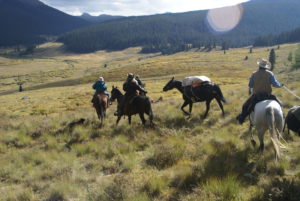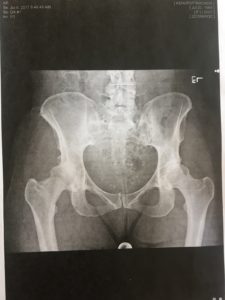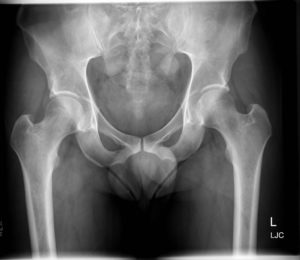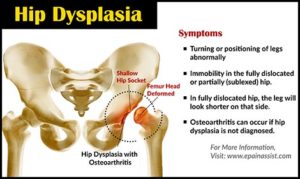On July 6th, 2017, I had my first ever visit with an Orthopaedic Surgeon, Dr. Shukla. It was a life-altering event that ultimately led to the creation of this blog.
I had been having problems with my right groin/hip for about 9 years, but had always figured I’d injured muscles and/or ligaments during my packing (horseback camping trips) days. Here’s a visual of what leading a pack horse looks like (I’m the long-haired rider in the black duster, getting tugged by my pack horse).

I’d been trying to rehab it with various forms of yoga and physical therapy since 2009, but by 2017, I was having constant pain and walking was becoming very difficult. Here’s the more detailed history of what happened (especially for my fellow hip people who may wish to compare notes):
Meeting Dr. Shukla
I was taken to a room and briefly interviewed about my problem. During this interview, I gave the assistant the above Hip History for Dr. Shukla to read. He must have read it while we were waiting for the Xrays to be taken. I recall sitting in the hallway waiting my turn with a bunch of other patients. I saw him peer around the corner of his office area and our eyes met. I had the distinct sense of him sizing me up. Then the Xrays were taken and I went back into the room to wait.
I’d done some research online and I knew that my symptoms indicated there might be something wrong with my hip and that it might even need to be replaced. But I was entirely unprepared for what happened next…
Dr. Shukla came in and introduced himself. I remember showing him the above picture and saying I thought that’s probably what caused my problem, that and probably a bunch of other things that stressed my hips, like lifting heavy weight and belly dancing. He said, “I think we should just go look at the Xrays. They tell the whole story.”
I followed him out to the computer screens where they display the Xrays. There I met his surgical assistant, Davis who had been looking at the screen and immediately pressed his card into my hand. I don’t remember what was said, only the message, that we would be seeing more of each other.
Dr. Shukla began with my LEFT hip. I recall thinking, “But, that hip’s not bothering me.” He proceeded to show me all the things that are wrong with my left hip. “You have congenital hip dysplasia. That means you have a very shallow hip socket and a deformed ball at the top of your femur. Normal hip sockets are a cup, you have a saucer. Normal femurs have a ball on the end.” He showed me where there were bone spurs growing indicating stress and the beginnings of osteoarthritis (white stuff in the xrays). He also pointed out how thin my cartilage is between my socket and femur (dark area surrounding head of the femur). In this case pictures are really worth a thousand words. Here’s my hip and next to it a normal hip:


Here’s a good description of hip dysplasia (Who knew it wasn’t just for dogs, you don’t know how many dog hips I’ve inadvertently looked at researching my condition!):

My head started to spin and I had to ground myself and breathe to stay focused.
Then he moved to my right hip. And I knew why he’d started with my left. There wasn’t enough left of the right hip to talk about what a hip joint should even look like. He said, “You have severe osteoarthritis in this hip due to your dysplasia (mine is bilateral, meaning both sides) and you are literally bone on bone.”
At that point, it sunk in that both my hips were deformed and both would need to be replaced. That was, and still is, the hardest thing to face.
He took me back to the office and we talked. He told me that being active my whole life was probably what helped me make it to 51 on my hips. This was such a reframe for me, since I’d thought I did something to cause this problem. He said I could try more physical therapy and he could do an injection for the pain. I said I’d tried rehabbing it and it doesn’t work. “Besides, when I look at that Xray, I don’t see anything left to work with.” He shook his head and acknowledged there wasn’t anything that would fix it, except a total hip replacement. In fact, he wasn’t really sure how I was walking at all, and just taking 2 ibuprofen and some wine to deal with the pain.
I told him I thought we needed to move forward with a replacement and he said he could probably fit me in in a few weeks and we should get started on the process. I asked how long I might have on my left hip and he told me, “Usually they either go right away or the surgery will give you more time on your left hip. We just have to see how your body reacts. You might get another 10 years, maybe.” I could tell that was the most optimistic projection.
He explained that my leg was not attached properly and he would have to change the angle of the attachment of my leg to my body, try to correct the leg length discrepancy, and drill a deep enough hole in my pelvis to try and make cup he could fit the implant into. I tried not to think about what all that meant. He said my leg would not feel the same afterwards and it would take some getting used to and physical therapy to learn to walk on it.
I remember saying, “Well, at least there’s a reason for all my pain and it’s fixable. I was afraid you would tell me there was nothing wrong and just keep trying to rehab it.” He smiled and shook his head. I don’t recall how many people I was introduced to that day who were going to be part of the process. It all sort of blurred together in my shocked mind. I walked out with a folder explaining how to prepare for surgery and what would happen, complete with a DVD. I was signed up for a joint replacement education class and a physical therapy assessment. It all happened so fast.
When I got home, my partner, Scott and our neighbors were in the garage. They all wanted to know what happened. I think I just handed them the xrays and started to cry. I remember them circling around me, embracing me and reassuring me they would all be here to help me through.